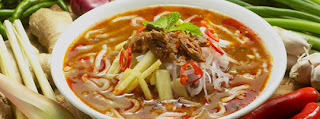Char kway teow,炒粿條 literally "stir-fried ricecake strips", is a popular noodle dish in
Malaysia,
Indonesia,
Brunei and
Singapore. The dish was (and still is in some places in Malaysia and Singapore) typically prepared at
hawker stalls especially in
Penang, Malaysia.
It is made from
flat rice noodles (河粉
hé fěn in
Mandarin Chinese) of approximately 1 cm or (in the north of Malaysia) about 0.5 cm in width, stir-fried over very high heat with light and dark
soy sauce,
chilli, a small quantity of
belachan, whole
prawns, deshelled
cockles,
bean sprouts and chopped
Chinese chives. The dish may commonly be stir-fried with egg, slices of
Chinese sausage and
fishcake, and less commonly with other ingredients.
Char kway teow is traditionally stir-fried in
pork fat, with crisp croutons of pork
lard, and commonly served on a piece of banana leaf on a plate.
Char kway teow has a reputation of being unhealthy due to its high
saturated fat content. However, when the dish was first invented, it was mainly served to
labourers. The high fat content and low cost of the dish made it attractive to these people as it was a cheap source of
energy and
nutrients. When the dish was first served, it was often sold by
fishermen,
farmers and cockle-gatherers who doubled as
char kway teow hawkers in the evening to supplement their income.
Ingredients:
300g kway teow (flat rice noodles)
200g prawns (shelled)
50g chives (cut into 3cm lengths)
150g beansprouts
1 chinese sausage (sliced)
3 eggs
2 cloves garlic (chopped)
4 tbsp cooking oil
1-2 tbsp chilli paste
Seasoning:
2 tsp light soya sauce
1 tsp dark soya sauce
a pinch of salt
a dash of pepper
Method:
1. Heat 4 tbsp oil in wok until hot, add chopped garlic and fry until fragrant. Turn up the heat and add the chilli paste (if used) and continue to fry until fragrant.
2. Add prawns, chinese sausage slices and beansprouts and fry for a while. Push all the fried ingredients to one side and add the kway teow (flat rice noodles) and stir-fry quickly for a few seconds.
3. Add seasoning, sprinkle with a little water and stir in all the fried ingredients. Push ingredients to the sides of the wok to create an empty space in the centre. Add a tbsp of oil and crack in the eggs. When the eggs start to set, cover the eggs with the noodle mixture and stir-fry evenly.
4. Finally, add the chives and stir-fry for 20 seconds before dishing up.
Chilli Paste:
2 tbsp chilli paste
10 shallots
1/2 tsp salt
5-6 tbsp oil
Method:
1. Blend skinned shallots and mix with chilli paste.
2. Heat oil in wok and fry the chilli paste over slow fire, stirring constantly until fragrant and until the oil separates from paste. Season with a little salt.






















